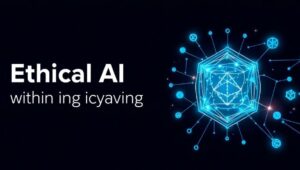Building Ethical AI Frameworks within Organizations: A 2025 Guide
As artificial intelligence (AI) becomes increasingly integrated into organizational structures, the need for ethical frameworks to guide its development and deployment is more critical than ever. This guide provides a comprehensive overview of how organizations can build and implement effective ethical AI frameworks by 2025.
Why Ethical AI Frameworks Are Essential
Ethical AI frameworks are sets of principles, guidelines, and processes designed to ensure that AI systems are developed and used responsibly. They address potential harms such as bias, discrimination, privacy violations, and lack of transparency. Implementing these frameworks can lead to:
- Increased Trust: Stakeholders are more likely to trust AI systems that are developed and used ethically.
- Reduced Risks: Ethical frameworks help identify and mitigate potential risks associated with AI.
- Compliance: Many regions are introducing regulations around AI ethics, making compliance essential.
- Enhanced Reputation: Organizations committed to ethical AI can enhance their reputation and brand value.
Key Components of an Ethical AI Framework
A robust ethical AI framework should include the following components:
-
Ethical Principles:
- Fairness: Ensure AI systems do not discriminate against individuals or groups.
- Transparency: Provide clear explanations of how AI systems work and make decisions.
- Accountability: Establish mechanisms to hold individuals and organizations accountable for the impacts of AI systems.
- Privacy: Protect individuals’ data and ensure compliance with privacy regulations.
- Beneficence: Maximize the benefits of AI while minimizing potential harms.
-
Governance Structure:
- AI Ethics Committee: A cross-functional team responsible for overseeing the ethical implications of AI projects.
- Ethical Impact Assessments: Regular assessments to identify and mitigate potential ethical risks.
- Whistleblower Mechanisms: Channels for reporting ethical concerns without fear of retaliation.
-
Technical Implementation:
- Data Auditing: Regular audits to identify and correct biases in training data.
- Model Explainability: Techniques to understand and explain how AI models make decisions (e.g., SHAP values, LIME).
- Privacy-Enhancing Technologies (PETs): Tools to protect data privacy, such as differential privacy and federated learning.
-
Training and Education:
- Ethics Training Programs: Educate employees on ethical AI principles and best practices.
- Awareness Campaigns: Promote ethical awareness throughout the organization.
- Continuous Learning: Stay updated on the latest developments in AI ethics and adjust the framework accordingly.
Steps to Build an Ethical AI Framework
-
Define Scope and Objectives:
- Identify the specific areas where AI is being used or planned for use.
- Determine the key ethical objectives based on organizational values and stakeholder expectations.
-
Assess Current Practices:
- Evaluate existing AI projects to identify potential ethical gaps and risks.
- Review data collection, processing, and usage practices.
-
Develop Ethical Guidelines:
- Create clear and actionable guidelines based on ethical principles.
- Ensure guidelines are aligned with relevant laws and regulations.
-
Implement Governance Structures:
- Establish an AI ethics committee with diverse representation.
- Develop processes for ethical impact assessments and incident reporting.
-
Provide Training and Education:
- Conduct regular training sessions for employees involved in AI development and deployment.
- Offer resources and support for ethical decision-making.
-
Monitor and Evaluate:
- Continuously monitor AI systems for ethical compliance.
- Regularly evaluate the effectiveness of the ethical framework and make necessary adjustments.
Challenges and Mitigation Strategies
- Challenge: Lack of awareness and understanding of AI ethics.
- Mitigation: Conduct comprehensive training programs and awareness campaigns.
- Challenge: Difficulty in identifying and mitigating biases in AI systems.
- Mitigation: Implement rigorous data auditing and model explainability techniques.
- Challenge: Ensuring accountability for AI-related decisions.
- Mitigation: Establish clear roles and responsibilities, and implement whistleblower mechanisms.
- Challenge: Keeping up with evolving AI technologies and ethical standards.
- Mitigation: Invest in continuous learning and regularly update the ethical framework.
The Future of Ethical AI
By 2025, ethical AI will be a fundamental requirement for organizations. Those that proactively build and implement ethical AI frameworks will gain a competitive advantage, foster trust with stakeholders, and contribute to a more responsible and equitable future. Staying informed, adaptable, and committed to ethical principles will be key to navigating the evolving landscape of AI ethics.
Conclusion
Building ethical AI frameworks is not just a matter of compliance but a strategic imperative for organizations aiming to thrive in an AI-driven world. By following this guide, organizations can create robust frameworks that ensure AI is developed and used in a responsible, transparent, and beneficial manner.




